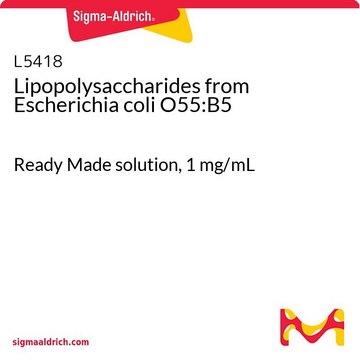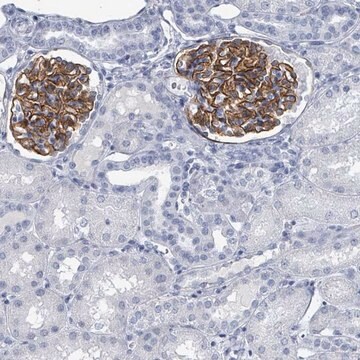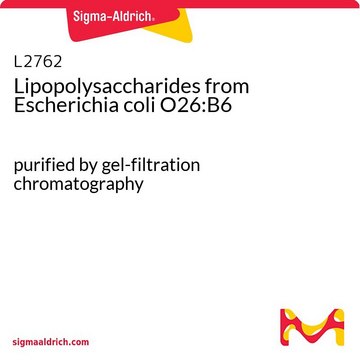L3129
Lipopolysaccharides from Escherichia coli O127:B8
purified by phenol extraction
Sinónimos:
LPS
Iniciar sesiónpara Ver la Fijación de precios por contrato y de la organización
About This Item
Productos recomendados
origen biológico
Escherichia coli (O127:B8)
Nivel de calidad
Formulario
lyophilized powder
purificado por
phenol extraction
impurezas
<3% Protein (Lowry)
color
white to faint yellow
solubilidad
water: soluble
Condiciones de envío
ambient
temp. de almacenamiento
2-8°C
¿Está buscando productos similares? Visita Guía de comparación de productos
Descripción general
This product is phenol extracted from E. coli serotype O127:B8. The source strain is ATCC 12740. This LPS serotype has been used in the study of septic shock and to induce NOS in murine macrophages and PAF synthesis in rat glomerular masangial cells.
Aplicación
Lipopolysaccharides (LPSs) are characteristic components of the cell wall of Gram-negative bacteria. LPS and its lipid A moiety stimulate cells of the innate immune system by the Toll-like receptor 4 (TLR4), a member of the Toll-like receptor protein family, which recognizes common pathogen-associated molecular-patterns (PAMPs).
Acciones bioquímicas o fisiológicas
Lipopolysaccharides (LPS) are localized in the outer layer of the membrane and are, in noncapsulated strains, exposed on the cell surface. They contribute to the integrity of the outer membrane, and protect the cell against the action of bile salts and lipophilic antibiotics.
Nota de preparación
The product is soluble in water (5 mg/ml) or cell culture medium (1 mg/ml) yielding a hazy, faint yellow solution. A more concentrated, though still hazy, solution (20 mg/ml) has been achieved in aqueous saline after vortexing and warming to 70-80 oC. Lipopolysaccharides are molecules that form micelles in every solvent. Hazy solutions are observed in water and phosphate buffered saline. Organic solvents do not give clearer solutions. Methanol yields a turbid suspension with floaters, while water yields a homogeneously hazy solution.
Otras notas
To gain a comprehensive understanding of our extensive range of Lipopolysaccharides for your research, we encourage you to visit our Carbohydrates Category page.
Producto relacionado
Referencia del producto
Descripción
Precios
Palabra de señalización
Danger
Frases de peligro
Consejos de prudencia
Clasificaciones de peligro
Acute Tox. 2 Oral
Código de clase de almacenamiento
6.1A - Combustible acute toxic Cat. 1 and 2 / very toxic hazardous materials
Clase de riesgo para el agua (WGK)
WGK 3
Punto de inflamabilidad (°F)
Not applicable
Punto de inflamabilidad (°C)
Not applicable
Elija entre una de las versiones más recientes:
¿Ya tiene este producto?
Encuentre la documentación para los productos que ha comprado recientemente en la Biblioteca de documentos.
Los clientes también vieron
Bo Wang et al.
Brain, behavior, and immunity, 72, 51-60 (2017-12-03)
Our previous study has reported that the proactive secretion and role of central high mobility group box 1 (HMGB1) in lipopolysaccharide-induced depressive behavior. Here, the potential mechanism of HMGB1 mediating chronic-stress-induced depression through the kynurenine pathway (KP) was further explored
Jeffrey A Haspel et al.
Nature communications, 5, 4753-4753 (2014-09-12)
Circadian rhythms are known to regulate immune responses in healthy animals, but it is unclear whether they persist during acute illnesses where clock gene expression is disrupted by systemic inflammation. Here we use a genome-wide approach to investigate circadian gene
Meichun Zeng et al.
Toxicology letters, 271, 26-37 (2017-03-02)
Acute lung injury (ALI) is a common clinical disorder that causes substantial health problems worldwide. An excessive inflammatory response is the central feature of ALI, but the mechanism is still unclear, especially the role of endoplasmic-reticulum (ER) stress and autophagy.
Xavier Brenachot et al.
Nature communications, 8(1), 1820-1820 (2017-11-29)
Obesity-induced inflammation engenders insulin resistance and type 2 diabetes mellitus (T2DM) but the inflammatory effectors linking obesity to insulin resistance are incompletely understood. Here, we show that hepatic expression of Protein Tyrosine Phosphatase Receptor Gamma (PTPR-γ) is stimulated by inflammation
Geoffroy Laumet et al.
Neuropsychopharmacology : official publication of the American College of Neuropsychopharmacology, 43(13), 2597-2605 (2018-07-29)
In humans, depression is often associated with low-grade inflammation, activation of the tryptophan/kynurenine pathway, and mild lymphopenia. Preclinical research confirms that inflammation induces depression-like behavior through activation of the tryptophan/kynurenine pathway. However, the mechanisms governing recovery from depression are unknown.
Nuestro equipo de científicos tiene experiencia en todas las áreas de investigación: Ciencias de la vida, Ciencia de los materiales, Síntesis química, Cromatografía, Analítica y muchas otras.
Póngase en contacto con el Servicio técnico




